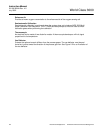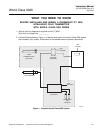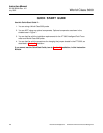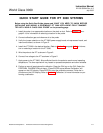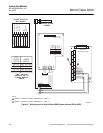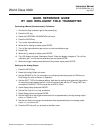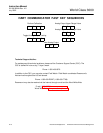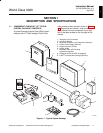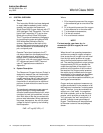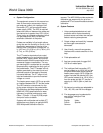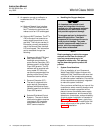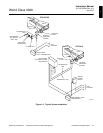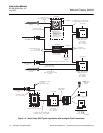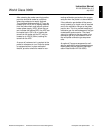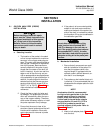
Instruction Manual
IB-106-300NH Rev. 4.2
July 2002
1-2 Description and Specifications Rosemount Analytical Inc. A Division of Emerson Process Management
World Class 3000
1-2 SYSTEM OVERVIEW
a. Scope
This Instruction Bulletin has been designed
to supply details needed to install, startup,
operate, and maintain the Rosemount
World Class 3000 Oxygen Analyzer with IFT
3000 Intelligent Field Transmitter. The Intel-
ligent Field Transmitter (IFT) can be inter-
faced with one World Class 3000 probe.
The IFT provides all necessary intelligence
for controlling the probe and optional MPS
3000 Multiprobe Calibration Gas Se-
quencer. Appendices at the back of this
manual detail each component and option
from the standpoint of troubleshooting, re-
pair, and spare parts.
Operator/Technician interface to the IFT
can be provided from the displays and key-
pads on the front panel, and remotely
through HART
®
communications protocol,
utilizing the 4-20 mA out-put signal from the
IFT interconnect board. HART Communi-
cator IFT applications are detailed in
Appendix J.
b. System Description
The Rosemount Oxygen Analyzer (Probe) is
designed to measure the net concentration
of oxygen in an industrial process; i.e., the
oxygen remaining after all fuels have been
oxidized. The probe is permanently posi-
tioned within an exhaust duct or stack and
performs its task without the use of a sam-
pling system.
The equipment measures oxygen percent-
age by reading the voltage developed
across a heated electrochemical cell, which
consists of a small yttria-stabilized, zirconia
disc. Both sides of the disc are coated with
porous metal electrodes. When operated at
the proper temperature, the millivolt output
voltage of the cell is given by the following
Nernst equation:
EMF = KT log10(P1/P2) + C
Where:
1. P2 is the partial pressure of the oxygen
in the measured gas on one side of the
cell,
2. P1 is the partial pressure of the oxygen
in the reference air on the other side,
3. T is the absolute temperature,
4. C is the cell constant,
5. K is an arithmetic constant.
NOTE
For best results, use clean, dry, in-
strument air (20.95% oxygen) as a ref-
erence air.
When the cell is at operating temperature
and there are unequal oxygen concentra-
tions across the cell, oxygen ions will travel
from the high partial pressure of oxygen
side to the low partial pressure side of the
cell. The resulting logarithmic output voltage
is approximately 50 mV per decade. Be-
cause the magnitude of the output is pro-
portional to the logarithm of the inverse of
the sample of the oxygen partial pressure,
the output signal increases as the oxygen
concentration of the sample gas decreases.
This characteristic enables the oxygen
analyzer to provide exceptional sensitivity at
low oxygen concentrations.
Oxygen analyzer equipment measures net
oxygen concentration in the presence of all
the products of combustion, including water
vapor. Therefore, it may be considered an
analysis on a "wet" basis. In comparison
with older methods, such as the Orsat ap-
paratus, which provides an analysis on a
"dry" gas basis, the "wet" analysis will, in
general, indicate a lower percentage of
oxygen. The difference will be proportional
to the water content of the sampled gas
stream.



